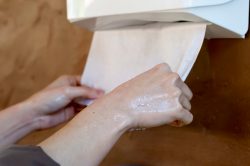 A recent study by a team at the University of Leeds, UK was set up to determine if the use of paper towels or air dryers is more effective for getting rid of microbes when the hands are still drying and contanminated.
A recent study by a team at the University of Leeds, UK was set up to determine if the use of paper towels or air dryers is more effective for getting rid of microbes when the hands are still drying and contanminated.
Hand drying is especially critical in helping decrease the spread of critical microbes which includes COVID-19. Failure to remove these microbes increases their transmission to environmental surfaces which increases the opportunity for them to be transmitted and spread. The study set out to investigate if there could be differences in the extent of transmission of the virus according to each hand drying method outside of the bathroom to a hospital environment.
Four participants simulated contamination of either their hands or gloved hands with a bacteriophage, a virus that can infect bacteria and is not harmful to humans. They did not wash their hands after contamination as the method used to simulate poorly and inadequately hand washing. They dried their hands using either a jet air dryer or paper towels. Each participant did wear an apron to ensure measurement of contamination of body/clothing while their hands dried. They dried their hands in a hospital bathroom and after the participants exited, samples were retrieved from both ward and public areas.
Environmental surface areas were sampled after the participant’s contact with hands or apron. These site samples included doors, stair handrails, chairs in ward and public areas, lift buttons, phones, buttons on intercoms to wards, stethoscope tubing and chest and head piece, the aprons, and armchairs that might have been indirectly exposed to the aprons. For the latter sample site, the participants were told to lay their arms across their chest while using the apron and before resting their arms on the chair.
The study team discovered that both paper towel and air dryer methods statistically significantly decreased virus contamination of hands. For 10 out of 11 areas tested, quite a high amount of environmental contamination was found after air dryers versus paper towel use. All surfaces sampled following the use of air dryers showed phage contamination compared to 6 surfaces after paper towel use. Average surface contamination following hand contact was more than 10 times higher after air dryer use versus paper towel use.
Viral dispersal to apron/clothing was 5 times higher with air dryers versus the paper towels. Phage transfer from aprons to armchairs via the crossed arms was detected only following air dryer use. This suggests that the transfer of microbes to environmental surfaces can occur directly from hands that remain contaminated after air drying, but also indirectly from a person’s body that has been contaminated during air drying.
The research team concluded that there are very distinct differences in regards to air drying versus paper towel drying in the residual microbial contamination of the participant’s body and hands. These differences in contamination translate into quite a bit greater microbe levels of contamination after air drying versus the use of paper towels from body and hands beyond the bathroom. Since public bathrooms are used by staff, visitors and patients, the hand drying method used can promote the increase (using air dryers) or decrease (using paper towels) pathogen transmission in hospitals.
The team also notes that their findings have significant importance since there has been a general migration from use of paper towels to more air drying in many settings and areas in the world. The World Health Organization’s hand washing guidelines recommend the use of paper towels to dry hands. And they also recommend using a paper towel to turn off the tap. The preferred method should be paper towels to dry hands following proper washing to help reduce the risk of virus contamination and spread.
To view the original scientific study click below





